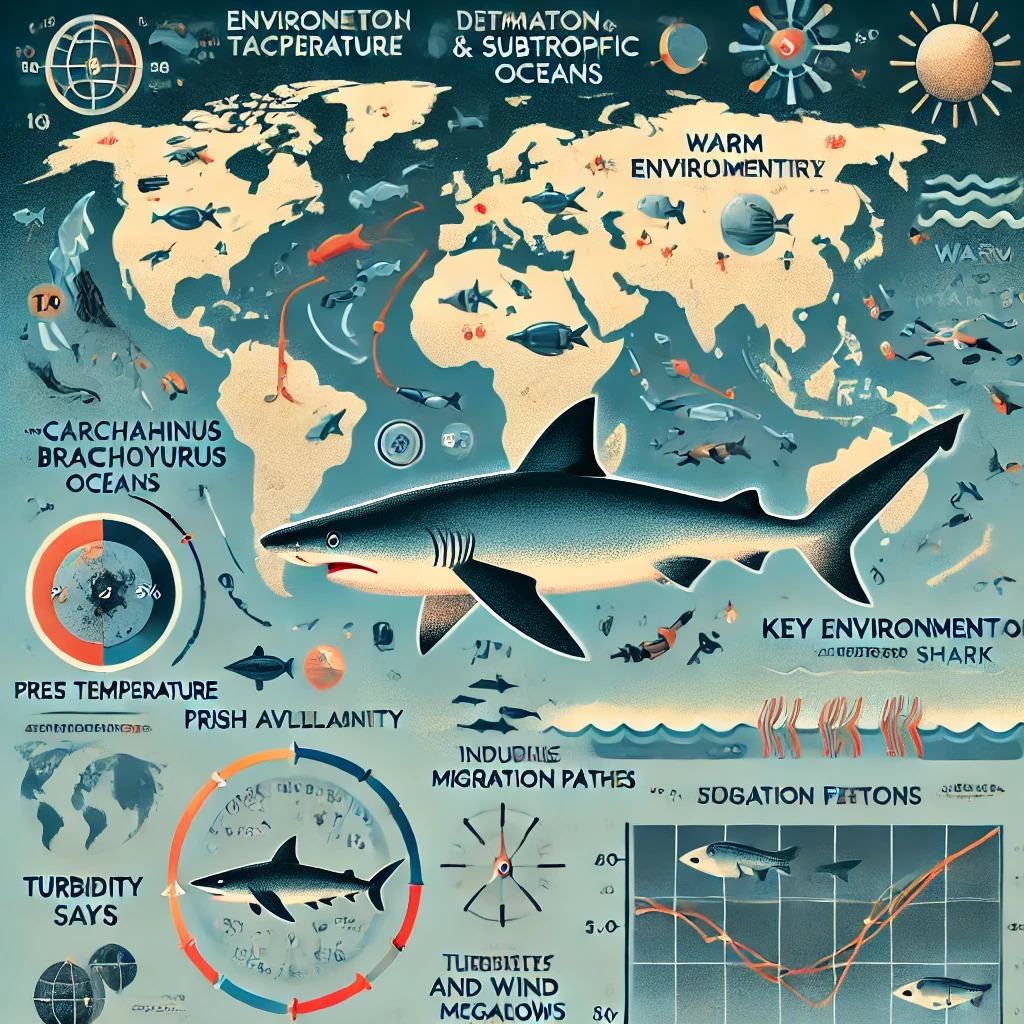(Carcharhinus brachyurus), also known as Bronze Whalers, are large, migratory apex predators that show circumglobal, patchy, and neritic distribution across temperate and subtropical coastal waters of the Atlantic and Indo-Pacific oceans and the Mediterranean Sea. The patchy distribution and migratory patterns of Carcharhinus brachyurus are fixed by some key environmental factors: water temperature, prey availability, habitat use, lunar illumination, turbidity, wind speed, and salinity.
Being ectothermic or cold-blooded, C. brachyurus is sensitive to changes in the water temperature and exhibits seasonal migration for thermoregulation. Their movements are associated with seasonal temperature variations, where they move to higher latitudes during summer and return to lower latitudes during winter. Moreover, with the onset of winter, temperature declines in coastal water, and as a response, C. brachyurus moves away from coastal waters to shelf and oceanic waters. Juvenile copper sharks use warm water temperatures to help increase their growth rate and metabolic activity. In areas with low water temperature, local upwelling occurs, and this in turn lowers the visibility. This nutrient-rich upwelling maximizes primary production, attracting zooplankton and teleosts. Consequently, turbid, nutrient-rich waters could increase teleost prey abundance and hunting success, thus affecting the Copper Shark distribution in those areas. According to a study conducted in South Africa, cool, upwelled water supports the annual northward migration of sardines (Sardinops sagax) known as the ‘sardine run,’ resulting in large sardine schools close to the coast, attracting C. brachyurus as sardines are the predominant prey species of them.

Wind speed and lunar illumination also positively impact on the distribution patterns of C. brachyurus. When the wind speed increases, it raises turbidity due to resuspended particulate matter, reducing prey’s ability to avoid predators and improving the foraging and hunting success of C. brachyurus. Additionally, juveniles prefer shallow, turbid waters to avoid predation by larger sharks. Several fish species, including sharks, show rhythms affected by moonlight, and these rhythms are linked to their behaviors like aggregation, migration, habitat use, and predation. Many of the key prey species of C. brachyurus inhabit seagrass meadows during the day and use moon illumination to hunt at night. This nocturnal increasing of feeding by key prey species results attracting copper sharks during night time of new moon periods. It implies the seasonal presence of these sharks, with their occurrence peaking from spring to early autumn.
C. brachyurus can tolerate a range of salinities and is found in bays, harbors, estuaries, continental shelves, and occasionally the lower reaches of rivers. This patchy distribution suggests that they select habitats that provide optimal conditions for feeding, breeding, and survival. Specifically, seagrass meadows act as nursery grounds for juveniles, and they have been returning to these areas seasonally and exhibit site fidelity in these areas too.
Understanding these environmental influences is essential for the conservation and management of C. brachyurus populations in the face of climate change and increasing anthropogenic pressure on coastal ecosystems.
References
- Drew, M., Rogers, P., Lloyd, M. et al. Seasonal occurrence and site fidelity of juvenile bronze whalers (Carcharhinus brachyurus) in a temperate inverse estuary. Mar Biol 166, 56 (2019). https://doi.org/10.1007/s00227-019-3500-x
- Andrzejaczek, S., DiGiacomo, A. E., Mikles, C. S., Pagniello, C. M. L. S., Reimer, T. E. J., & Block, B. A. (2024). Lunar cycle effects on pelagic predators and fisheries: insights into tuna, billfish, sharks, and rays. Reviews in Fish Biology and Fisheries.
- Wintner, S. P., & Kerwath, S. E. (2017). Cold fins, murky waters and the moon: what affects shark catches in the bather-protection program of KwaZulu–Natal, South Africa? Marine and Freshwater Research, 69(1), 167-177.
- Lucifora, L., Menni, R., & Escalante, A. (2005). Reproduction and seasonal occurrence of the copper shark, from north Patagonia, Argentina. ICES Journal of Marine Science, 62(1), 107– 115